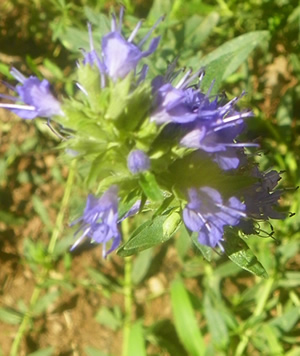Hyssop Hyssopus officinalis

hyssop bush blossoming
- Common Names
- Hyssop
- Botanical Name
- Hyssopus officinalis
- Family
- LAMIACEAE
Medicinal Uses & Benefits of Hyssop
![]() How to Use|
Side Effects |
Plant & Garden|
Aromatherapy Oil |
How to Use|
Side Effects |
Plant & Garden|
Aromatherapy Oil |
- Medicinal Uses: * Aromatherapy
* Bronchitis
* Bruises/sprains
* Burns
* Cardiovascular
* Congestion
* Congestion
* Dental/Oral Care
* Facial Care
* Flu
* Herpes/Cold Sores
* Hypertension
* IBS
* Insect Repellent
- Properties: * Adaptogens * Antispasmodic * Aromatic * Carminative * Cicatrisant * Cordial * Diaphoretic * Digestive * Diuretic * Emmenagogue * Expectorant * Febrifuge * Hypertensive * Hypotensive * Nervine * Sedative * Vermifuge * Vulnerary
- Parts Used: Flowers, leaf and essential oil
- Constituents: volatile oil ,pinocamphone, isopinocamphone, pinenes, camphene, and terpinene),hyssopin, tannin, flavonoids, insolic acid, oleonolic acid, a bitter substance (marrubiin), resin, gum
How to Use: Hyssop
Hyssop is a good expectorant and antiviral herb commonly used to treat respiratory conditions such as influenza,sinus infections, colds, and bronchitis. Most of its medicinal properties are attributed to the essential oil of hyssop. Hyssop oil can be diffused in a sickroom to help control germs and clear the air. Hyysop can also be used externally to treat burns and bruises. Hyssop is a nervine, and can be used to calm anxiety. The herbs bitter principle, marrubin, also contributes to its use as a digestive stimulant. 1, 2
Preparation Methods & Dosage :Traditionally used in teas, also found as a capsule or extract. Always brew hyssop tea in a closed vessel and keep the bottle of hyssop tincture tightly closed to prevent the essential oil from evaporating. The essential oil may be diluted and used in external applications, or in a diffuser.
Hyssop Remedies
Hyssop : Essential Oil Profile
Essential oil of hyssop is a light golden-yellow color, it is fairly expensive. The scent is difficult to describe, it is not like any other, but is somewhat like a mixture of basil, geranium and thyme. Hyssop is an effective decongestant and disinfectant and has a calming effect, soothing to nervous tension.
Hyssop Side Effects: Because it contains ketones (pino-camphone), although in infinitesimal quantities, the essence is toxic in high doses, causing epileptic attacks in those predisposed to them. Not for use in pregnancy.
Plant Description

Hyssop flowers
Common in the Midi region of France and cultivated in gardens as an aromatic and medicinal herb. Hyssop is a hardy perennial with narrow green leaves and very aromatic royal-blue, white, or pink flowers
How to Grow Hyssop
Full sun, woody perenial. Sow seeds in early spring
History and Traditions & Folklore
Hyssop comes from the Hebrew name AEsob, and from the Greek hysoppus. The plant is mentioned many times in the Bible, and is one of the bitter herbs to be taken over passover. Hippocrates, Galen, and Dioscorides all recommended hyssop, mentions of the plant appear in all the great herbals of the middle ages. 3- Hoffmann, David (2010-12-15). Medical Herbalism: The Science and Practice of Herbal Medicine (p. 560). Healing Arts Press.
- John King, Harvey Wickes Felter. "King's American Dispensatory", Ohio Valley Co. (1909)
"stimulant, aromatic, carminative and tonic. Principally used in quinsy and other sore throats, as a gargle, combined with sage and alum, in infusion sweetened with honey. Also recommended in asthma, coughs, and other affections of the chest, as an expectorant. The leaves applied to bruises, speedily relieve the pain, and disperse every spot or mark from the affected parts."
- Walji, Hasnain, Ph.D."The Healing Power of Aromatherapy",Prima (1996),











